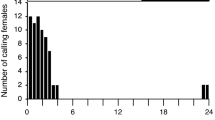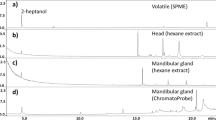Abstract
The greater wax moth, Galleria mellonella (L.), is a serious and widespread pest of the honeybee, Apis mellifera L. In contrast to most moths, for which long-range mate finding is mediated by female-produced sex pheromones, G. mellonella males attract conspecific females over long distances by emitting large amounts of a characteristic scent in combination with bursts of ultrasonic calls. The male scent for this species was previously identified as a blend of nonanal and undecanal. When these compounds were bioassayed, characteristic short-range sexual behavior, including wing fanning, was triggered in conspecific females, but the aldehyde blend failed to elicit attraction over longer distances. We identified, via analysis and synthesis, a third male-specific compound, 5,11-dimethylpentacosane. We show that it acts as a behavioral synergist to the aldehydes. In wind tunnel experiments, very few female moths responded to the aldehyde blend or to 5,11-dimethylpentacosane tested separately, but consistently showed orientation and source contact when a combination of all three compounds was applied. The level of attraction to the three-component mixture was still lower than that to male extract, indicating that the composition of compounds in the synthetic blend is suboptimal, or that additional pheromone components of G. mellonella are yet to be identified. The identification of 5,11-dimethylpentacosane is an important step for the development of an efficient long-range attractant that will be integrated with other environmentally safe strategies to reduce damage to beehives caused by wax moths.






Similar content being viewed by others
References
Abdalla FC, Jones GR, Morgan ED, Cruz-Landim C (2003) Comparative study of the cuticular hydrocarbon composition of Melipona bicolor Lepeletier, 1836 (Hymenoptera, Meliponini) workers and queens. Genet Mol Res 2:191–199
Bagnères AG, Morgan ED (1990) A simple method for analysis of insect cuticular hydrocarbons. J Chem Ecol 16:3263–3276
Birch MC, Poppy GM, Baker TC (1990) Scents and eversible scent structures of male moths. Annu Rev Entomol 35:25–58
Dahm KH, Meyer D, Finn WE, Reinhold V, Röller H (1971) The olfactory and auditory mediated sex attraction in Achroia grisella (Fabr.). Naturwissenschaften 58:265–266
Flint HM, Merkle JR (1983) Mating behaviour, sex pheromone responses and radiation sterilization of the greater wax moth (Lepidoptera: Pyralidae). J Econ Entomol 76:467–472
Kalinová B, Kindl J, Jiroš P, Žáček P, Vašíčková S, Buděšínský M, Valterová I (2009) Composition and electrophysiological activity of constituents identified in male wing gland secretion of the bumblebee parasite Aphomia sociella. J Nat Prod 72:8–13
Kindl J, Kalinová B, Červenka M, Jílek M, Valterová I (2011) Male moth songs tempt females to accept mating: the role of acoustic and pheromonal communication in the reproductive behaviour of Aphomia sociella. PLoS One 6(10):e26476
Lassance JM, Löfstedt C (2009) Concerted evolution of male and female display traits in the European corn borer, Ostrinia nubilalis. BMC Biol 7:10
Leyrer RL, Monroe RE (1973) Isolation and identification of the scent of the moth, Galleria melonella, and a reevaluation of its sex pheromone. J Insect Physiol 19:2267–2271
Lockey KH (1988) Lipids of the insect cuticle: origin, composition and function. Comp Biochem Physiol 89B:595–645
Nielsen RA, Brister CD (1977) The Greater wax moth: adult behavior. Ann Entomol Soc Am 70:101–103
Nielsen RA, Brister CD (1979) Greater wax moth: behaviour of larvae. Ann Entomol Soc Am 72:811–815
Payne TL, Finn WE (1977) Pheromone receptor system in the females of the greater wax moth Galleria mellonella. J Insect Physiol 23:879–881
Phelan LP (1997) Evolution of mate-signaling in moths: Phylogenetic considerations and predictions from the asymmetric tracking hypothesis. In: Choe JC, Crespi BJ (eds) The evolution of mating systems in insects and arachnids. Cambridge University Press, Cambridge, pp 240–256
Romel KE, Scott-Dupree CD, Carter MH (1992) Qualitative and quantitative analyses of volatiles and pheromone gland extracts collected from Galleria mellonella (L.) (Leptidoptera: Pyralidae). J Chem Ecol 18:1255–1268
Schmidt SP, Monroe RE (1976) Biosynthesis of the waxmoth sex attractants. Insect Biochem 6:377–380
Spangler HG (1986) Functional and temporal analysis of sound production in Galleria mellonella (Lepidoptera: Pyralidae). J Comp Physiol A 159:751–756
Spangler HG (1987) Acoustically mediated pheromone release in Galleria mellonella (Lepidoptera: Pyralidae). J Insect Physiol 7:465–468
Steinmetz I, Schmolz E, Ruther J (2003) Cuticular lipids as trail pheromone in a social wasp. Proc R Soc Lond B 270:385–391
Svensson GP, Löfstedt C, Skals N (2004) The odour makes the difference: male moths attracted by sex pheromones ignore the threat from predatory bats. Oikos 104:91–97
Tachinami T, Nishimura T, Ushimaru R, Noyori R, Naka H (2013) Hydration of terminal alkynes catalyzed by water-soluble cobalt porphyrin complexes. J Am Chem Soc 135:50–53
Witzgall P (1997) Modulation of pheromone-mediated flight in male moths. In: Cardé RT, Minks A (eds) Insect pheromone research: New directions. Chapman and Hall, New York, pp 248–264
Acknowledgments
We thank Hany Dweck for sending moth larvae, Dr Palle Breistein for part of the syntheses of pentacosanes, and Dr Joakim Bång for purification of moth extracts and some initial GC/MS analyses. Jon Loman provided wax cakes for the last instar larvae. This study was supported by a joint research grant under the Middle East and North Africa – Swedish Research Links Program to EAG and OA, and from grants by The Swedish Research Council (VR) and Birgit and Sven Håkan Ohlsson foundation to CL. NS and EH are grateful for the financial support from the European Union European Regional Development Fund and the County Administrative Board of Västernorrland.
Author information
Authors and Affiliations
Corresponding author
Electronic Supplementary Material
Below is the link to the electronic supplementary material.
ESM 1
(DOC 1777 kb)
Rights and permissions
About this article
Cite this article
Svensson, G.P., Gündüz, E.A., Sjöberg, N. et al. Identification, Synthesis, and Behavioral Activity of 5,11-Dimethylpentacosane, A Novel Sex Pheromone Component of the Greater Wax Moth, Galleria Mellonella (L.). J Chem Ecol 40, 387–395 (2014). https://doi.org/10.1007/s10886-014-0410-8
Received:
Revised:
Accepted:
Published:
Issue Date:
DOI: https://doi.org/10.1007/s10886-014-0410-8




